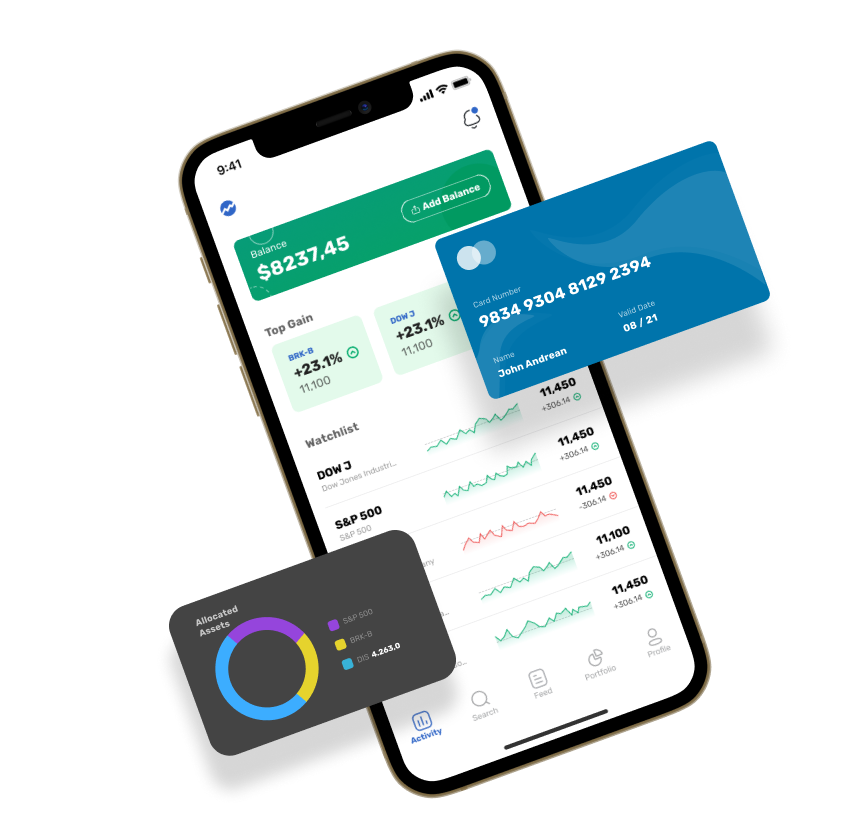20 Best Facts To Picking AI Stock Picker Analysis Websites
20 Best Facts To Picking AI Stock Picker Analysis Websites
Blog Article
Top 10 Suggestions For Evaluating The Integration Of Ai Analyzing/Predicting Stocks Trading Platforms
Integration and compatibility are key elements when it comes to considering AI platforms for analyzing and predicting stocks. Platforms that seamlessly integrate with the existing workflows, tools and systems will increase efficiency and productivity. These are the top 10 tips for assessing the compatibility and integration of these platforms:
1. Check Brokerage Integration
Supported brokers: Ensure that the platform integrates with the brokerage you prefer account, or trading account.
Trade execution: Verify if the platform allows direct trade execution using the broker integrated.
Account Synchronization: Make sure whether your platform is able to sync real-time balances of your account as well as positions and transaction history.
2. Assessment of API availability
API access: Make sure the platform provides an API (Application Programming Interface) for developers to build customized tools or automate workflows.
API documentation: Review for examples that clearly demonstrate how the API can be utilized.
Rate limits: Verify whether the API has reasonable rate limits and can handle your expected usage volume.
3. Examine the Third-Party Tool Integration
Popular tools: Make sure that the platform can be integrated with other tools such as Excel or Google Sheets.
Import and export of data. Be sure the platform is able to easily export or import from or to any other tool.
Plugins/extensions : Verify that your platform supports extensions or plugins. These add functionality.
4. Test Compatibility With Operating Systems
Desktop compatibility: Make sure that the application works with the operating system you prefer (Windows, macOS, Linux).
Mobile compatibility: Check if the platform offers a mobile app for iOS as well as Android.
Web-based access: Check that the platform can be accessed via a web browser for added flexibility.
5. Evaluation of Data Integrity Capabilities
Data sources: Check that the platform integrates with multiple data sources (e.g. market data sources or news feeds).
Real-time Data Feeds: Check to see if your service offers real-time analysis.
Import historical data - Make sure whether your platform allows you to add historical data to your backtesting software or analytical software.
6. Assess cloud and On-Premise Compatible
Cloud-based platforms: Make sure that the platform is available from any location that has an internet connection.
On-premise solutions. If you're looking to deploy on-premise be sure to check whether your platform supports it.
Take a look at the hybrid model. It blends on-premise with cloud capabilities.
7. Make sure to check for Cross Platform Synchronization
Device synchronization. Make sure that settings and data are synchronized across all platforms (desktops tablets and mobiles).
Real-time updates: Make sure that the changes you make on one device instantly appear on the other devices.
Offline Access: Check for any limitations on the capabilities of the platform or access to data if it is offline.
8. Assessment of the degree of compatibility with trading strategies
Algorithmic Trading: Ensure that the platform is compatible with algorithmic or automated trading strategies.
Custom indicators: Determine if your platform supports indicators or scripts that are specific to your needs.
Backtesting strategy: Find out that your platform allows you to backtest trading strategies with historical data.
9. Review Security and Compliance
Data encryption: Make sure that the platform utilizes encryption of data in the both in transit and at rest.
Authentication : Verify that the platform has safe authentication methods (e.g. 2-factor authentication).
Compliance with regulations - Make sure the platform complies pertinent laws, e.g. GDPR. FINRA. SEC.
10. Test Scalability and Performance
Scalability: Make sure the platform can handle an ever-growing amount of data as well as users to ensure that it is able to grow with your business.
Performance during load conditions: Verify whether the platform continues to be responsive during high-volatility market conditions.
Resource usage: Find out the extent to which your platform is using the resources of its system (CPU/memory and bandwidth) efficiently.
Bonus Tips
User feedback: Make use of user testimonials to evaluate the platform integration capabilities.
Trial period: Take advantage of a no-cost demo or trial to see how the platform works with other processes and tools.
Customer support: Ensure that your platform has a solid customer support to integrate-related issues.
These tips will assist you in assessing the ability to integrate seamlessly and with ease AI trading platforms which predict and analyze price of stocks. They will also enhance your trading performance. Read the best related site on ai investing app for site recommendations including investing ai, ai investment app, stock ai, best ai trading software, ai investment platform, chatgpt copyright, incite, options ai, investment ai, ai trade and more.
Top 10 Tips For Evaluating The Regulatory Compliance Of Ai Stock Predicting/Analyzing Trading Platforms
The compliance with regulatory requirements of trading platforms that employ AI to forecast or analyze stock prices is an important factor. Compliance helps to ensure that the platform is operating within the legal frameworks and safeguarding the privacy of users. Here are the top 10 ways to evaluate the regulatory compliance of such platforms:
1. Verify registration and licensing
Regulatory bodies: Ensure your platform is registered and licensed by relevant financial regulatory bodies (e.g., SEC in the U.S., FCA in the UK, ASIC in Australia).
Check that the brokers included in the platform are licensed and regulated.
Public records: Go to the regulator's website to check on the status of registration, as well as the history of violations.
2. Compliance with Data Privacy Evaluation
GDPR when operating in the EU or providing services to EU users the platform must comply with the General Data Protection Regulation.
CCPA -- California Consumer Privacy Act: Verify compliance of California users.
Policy on handling data: Make sure you read the privacy policies to learn the way in which user data is collected and stored.
3. Assessing Anti-Money Laundering measures
AML Policies: Make sure the platform you use has AML policies that are robust to detect and stop money laundering.
KYC procedures. See whether your platform is following Know Your Customer processes for authenticating user identities.
Check the platform's transaction monitoring. Does it track transactions and report any suspicious activity to authorities?
4. Check for the compliance of Trading Regulations
Market manipulation: Make sure that the platform has safeguards put in place to protect against market manipulation, including spoofing trading and wash trading.
Types of orders. Verify whether your platform is in compliance with the rules for order types.
Best execution: Make sure to see if the platform is adhering to the best execution method which guarantees that trades are executed at the lowest possible cost.
5. Cybersecurity Assessment
Data encryption: Ensure that the platform has encryption in place to protect the data of users in transit and at rest.
Response to incidents: Verify if the platform has a clear incident response strategy for data breaches or cyberattacks.
Certifications - Find out if your platform has any cybersecurity certifications.
6. Transparency Evaluation and Transparency Evaluation and
Disclosure of fees. Make sure that all fees and charges are clearly stated, as well as any additional or hidden costs.
Risk disclosure: Make sure there are clear and explicit disclosures about the risk, especially in high-risk or leveraged trading strategies.
Performance reporting: Check if the AI model's algorithms are transparent and properly reported.
7. Make sure that the product is in compliance with International Regulations
Cross-border trading If you plan to trade internationally make sure the platform is compliant in all jurisdictions.
Tax reporting: Check if there are tools or reports available to assist you with the tax regulations.
Sanctions compliance - Make sure that the platform adheres with international sanctions and does permit trading only with countries or entities prohibited.
8. Reviewing Audit trail trails and Record-Keeping
Transaction records: Verify that the platform keeps detailed records for regulatory purposes and for audit.
Logs of user activity: Check if the platform logs the user's activity, such as trading, logins, as well as changes to account settings.
Check for audit readiness: Determine whether your system can produce the necessary logs and documentation in the case of an inspection by a regulatory agency.
9. Verify compliance with AI Specific Regulations
Algorithmic rules for trading: If a platform permits the use of algorithms, it has to be in compliance with European regulations, such as MiFID II and U.S. Reg SCI.
Bias & Fairness: Check for any biases that the platform is able to detect and reduce within the AI model. This will ensure ethical and fair trade.
Explainability - Ensure that the system is able to give clear and concise explanations about AI-driven predictions, decisions and more. in accordance with certain regulations.
Review User Feedback and Regulatory History
Reviews from users: Perform user studies to determine the platform's reputation regarding legal compliance.
The history of regulatory compliance: Find out whether the platform has any past history of violations by the regulatory authorities, fines, or penalties.
Third-party auditors: Make sure that the platform is audited regularly by third parties to make sure it is adhering to the rules.
Bonus Tips
Legal consultation: Consult an expert in the field to verify whether your platform is in compliance with the regulations.
Trial period. Try the trial or demo of the platform to try out its features for compliance.
Support for customers: Make sure that the platform offers support to customers with questions or concerns related to compliance.
With these suggestions, you can effectively assess the regulatory compliance of AI platforms for stock prediction and analysis and ensure that you select one that adheres to legal guidelines and protects your interests. Compliance not only lowers legal risks, but also increases trust and confidence in the platform's services. Take a look at the recommended ai stock analysis blog for blog examples including chart analysis ai, ai software stocks, best ai for stock trading, stocks ai, investing with ai, ai in stock market, best ai stock prediction, ai investment tools, ai stock predictions, best ai stocks and more.